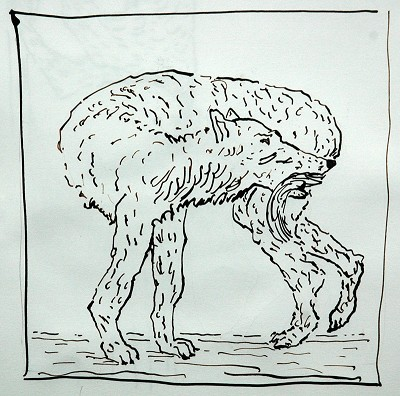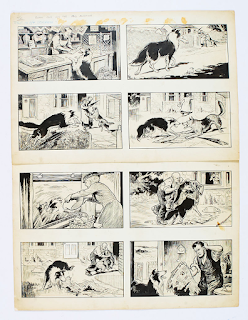Value the hybrid and the clone.
Twelve Principles for making art in a time of the Anthropocene
After undertaking a course in permaculture design last year, one of the things I promised myself I would do was to go back to the 12 principles of permaculture that I tried to apply to my then art practice and to see if they could be further reshaped, as I began to develop a more research led aspect to my work. I might of course continue to change them as my work unfolds, but the process does help to remind myself that I'm unable to extract what I'm doing from the wider ethical and ecological concerns of my time.
Things to consider when making art in a time of the Anthropocene.
The Anthropocene is the geological epoch that we currently inhabit. A time when human activities have had a significant impact on the planet. The word is a hybrid, combining the Greek anthropo (human) and cene (new) and it suggests that in order to inhabit our world in a proper manner, a drastic change is needed. The reality we seem to be faced with, is that we have already impacted upon the world's ecosystems to such a degree that the future of our species is cast in doubt. Science tells us that there have been several extinction events in the past and that the majority of them involved climate change. We therefore face an existential threat, far beyond war or localised environmental disaster. If faced with such a dilemma, I believe we have to construct some sort of resilient framework out of which we can still operate on a day to day basis, without just lapsing into despair. I have just spent a week walking and drawing in the landscape, observing the flow and ebb of vegetation in relation to landforms and changes in soil, as well as simply standing looking at the wonder of leaves moving in the wind and trying to make marks that capture the experience, not just from my point of view but from that of birds, insects and the tree itself. As I draw, I become lost in the moment and become aware that all experiences are in reality as significant as that moment of a breeze moving through the dense masses of a tree's leaf structure. The moment of a life of some extinct creature from before any of the previous extinction events, was just as wonderful, as will be all the moments of being in the world that all the creatures of the future will have and in that realisation, perhaps there is a reason to be hopeful and resilient as we all face an unknown future.
1. Observe and Interact
Humans are not the centre of everything. Try to observe the processes of the world through the senses of others. How would a tree feel about the situation, a snail, soil, a bird, a mountain or a fish. Use process led observations that immerse us into the lives of others, rather than using an objective fixed viewpoint in order to measure something.
As an artist making observations and responding to what has been seen is often central to the way work is developed. The more we look, the argument went, the more we can learn, but perhaps we can focus more on observing the nature of systems of interaction, be these about the interaction of people, people and things, people and other animals, things and animals, things and things, i.e. trying to open our vision out to include non human others, and events, so that we can move ourselves away from always being the centre of everything and valuing the world in relation to what we can own. We can experience events and interact with them but beware of seeing things simply as nouns, try to keep an eye on how processes are shaping the world around us.
2. Catch and Store Energy
As well as exploring the possibility of projects that can directly respond to the storage of energy, such as creative planting and growing, art making can itself be seen as an energy store. Operate to make artwork like a battery; create work that can recharge others, by layering and folding within the things you make, ideas and thought forms that unfurl in others minds as an energy release and not an energy drain. Look for the channels of energy movement that allow you to communicate without wasting energy, and let nature be your guiding principle.
3. Obtain a Yield
Non-tangible yields can be happiness, health, joy in making or mental well-being. Practicing the close observation of nature can lead to mental well-being. Develop processes of art making can be used as mindful exercises and these coupled with more sustainable approaches to art making, can become embedded into a lifelong approach to working with, as opposed to working against nature. Always check that what you are doing is leading towards a positive outcome for both humans and the rest of the world. Make things that the community needs, not just what you want.
4. Apply Self-Regulation and Feedback
A regular critique of what we do needs to become central to art practices. Increase an awareness of how your work impacts on sustainability, and build more robust tools with which to analyse your various working practices in relation to their impact upon the world. Use iterative processes. Make it, test it, tweak it, repeat. Make it, test it, tweak it, repeat.
5. Use and Value Renewables
By using the power of the sun, the wind, or water, we can harness non fossil fuel based energies to make our artworks. We can also in the reuse of materials ensure that the work we make does not use up any unnecessary energy or bring into the world new objects that use up the worlds limited supply of resources. To make full use of renewable sources of energy: and to move to a more sustainable way of operating as an artist. To include these issues in any proposals for future artworks and to use renewables whenever possible within art practices. Recycle, rebuild and repair whenever possible.
Renewables are sometimes ideas, rather than materials. Never discount an old idea, it is always possible to renew the way we approach our familiarity with things.
6. Produce No Waste
Moving towards a zero waste lifestyle means looking at all the artwork we make and eliminating any associated waste. We can do this by reducing the amount we buy, by buying wisely, by reusing or recycling wherever possible the materials we use to make our art. To look at waste throughout the entire life-cycle of all the products that we use we can reconsider what we make our artworks from. Are there possibilities for recycling when making work, how can the idea of recycling be embedded into the conceptual development of an artwork? Does an artist need to make anything? Do we need to move away from making objects and work towards the freeing of art from a material framework?
7. Design from Patterns to Details
Whether designing a new vegetable garden, or an entire new sustainable way of life, we have to look at the big picture before we get bogged down in the little things. Thinking holistically, about all areas of our lives, can help us move forwards in a positive direction. By being aware of the bigger picture we can develop a much more robust framework within which to work. Many artists historically have developed manifestos for practice, permaculture principles could be the pattern for the development of these. Are there other ecologically sound frameworks that could be used as models for art practice? Do the details of your work reflect the shape of the overall concept?
8. Integrate Don’t Segregate
Think about collaboration in all its forms. Collaborate with other artists, with non artists and with non humans. Work with the land, work with the air and the sea. Create work from a number of perspectives and use a variety of ways of making and thinking. Think of how to exhibit diverse forms together in the same space. Think about how your art practice can be integrated into and with others. Check on how your work effects others, and then bring all stakeholders into the fold of your practice. Explore who and what you could cooperate with. Value the hybrid and the clone.
9. Use Small, Slow Solutions
That scrap of paper with a sketched out concept might be as powerful as a huge sculpture. Begin small and gradually grow your ideas in conjunction with sustainable thinking. Work slowly, savour the process of the gradual growth of a concept as it moves from one stage to another. Take your time. Work with complicated ideas that take a while to ferment. Don't expect instant gratification. Big is rarely better. Work at the pace of the Earth.
10. Use and Value Diversity
Diversity is vital to how you communicate your ideas. Who's culture are you celebrating? Who's aesthetics are you working with? Does your work communicate beyond your subgroup preoccupation? Who are you talking to and how do you value others? Try to work through as many media as possible when trying out ideas. Allow other points of view to enter the development process of your ideas. Above all remember to value the culture of others, not just other humans, but other creatures too.
11. Use Edges and Value the Marginal
Use of all the resources that you have at your disposal, not just the ones within easy reach. Whether we’re talking about land use, materials, ideas, work places, art or society in general, making use of all we have involves valuing fringes and fringe elements. This might be as simple as using a neglected corner of your outside space to grow more food, or something more abstract, like thinking outside the box. Artists have traditionally been able to operate within and around the edges of society. Can this position be fostered and strengthened so that you are actively working to bring ideas from the edge of society into its centre? Artists have traditionally been the people that see things that others don't, can we can use this principle as a way to develop value in the marginalised?
12. Creatively Use and Respond to Change
Finally, change is an inevitable part of life. It’s important to remember that permaculture isn’t just about now, but about the future. We design for change, understanding that things will alter over time. The changing seasons, changing attitudes, our changing climate. How we respond to these changes will shape sustainable progress in the years to come. These principles are a starting point for an understanding of a permaculture influenced approach to art making, and can begin to give us an idea of how we can translate thought into action, an action that in itself might help in the transition to a more ethical – and truly sustainable – way of life. We should make art to discover our future, not to sustain the past. Many of our approaches to art making are rooted in models that are now outmoded. We don't need to make art for museums, we need to make it to survive.
If not we are simply waiting for the barbarians.





































































